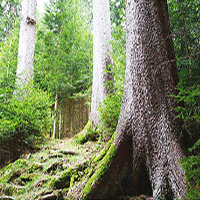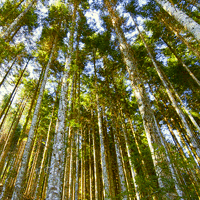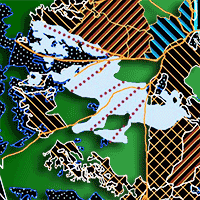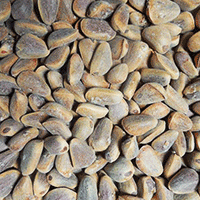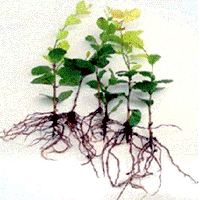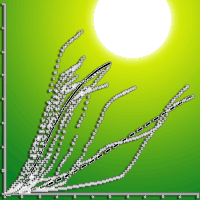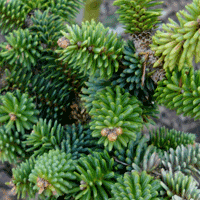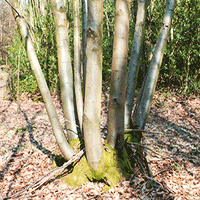An increase in ungulate abundance in Europe in recent decades has raised concerns for the survival of browse-sensitive tree species in its early life history stages. A possible strategy for mitigating the browsing-induced mortality of natural regeneration is to optimize silviculture. We used matrix population models parameterized for three types of Abies alba - Picea abies - Fagus sylvatica forests (3,183 permanent sample plots from three study areas in Slovenia, 39,717 ha), and a non-linear optimization to: (i) schedule optimal timing and intensity of logging in the next 100 years to increase the recruitment of Abies alba without intervening in the population of ungulates; and (ii) examine the influence of different natural recruitment rates on the potential for mitigating recruitment failure through silviculture optimization. The optimal management has required species-, growth- and diameter-specific logging, including intensive logging of large-diameter Abies alba in the first decades and strict conservation of recruits. The potential for mitigating recruitment failure through optimization increased progressively with natural recruitment rate and progressively at a decreasing rate with time. Optimizing silviculture was effective for maintaining Abies alba in stands exposed to low or moderate browsing pressures. Faced with chronic ungulate herbivory, forest managers should primarily focus on the reduction of herbivory and to a lesser extent on optimizing silviculture.
Keywords
, , , ,
Citation
Ficko A, Roessiger J, Bončina A (2018). Optimizing silviculture in mixed uneven-aged forests to increase the recruitment of browse-sensitive tree species without intervening in ungulate population. iForest 11: 227-236. - doi: 10.3832/ifor2567-011
Paper history
Received: Jul 27, 2017
Accepted: Jan 12, 2018
First online: Mar 12, 2018
Publication Date: Apr 30, 2018
Publication Time: 1.97 months
© SISEF - The Italian Society of Silviculture and Forest Ecology 2018
Open Access
This article is distributed under the terms of the Creative Commons Attribution-Non Commercial 4.0 International (https://creativecommons.org/licenses/by-nc/4.0/), which permits unrestricted use, distribution, and reproduction in any medium, provided you give appropriate credit to the original author(s) and the source, provide a link to the Creative Commons license, and indicate if changes were made.

Breakdown by View Type
(Waiting for server response...)
Article Usage
Total Article Views: 48908
(from publication date up to now)
Breakdown by View Type
HTML Page Views: 41199
Abstract Page Views: 3332
PDF Downloads: 3378
Citation/Reference Downloads: 17
XML Downloads: 982
Web Metrics
Days since publication: 2841
Overall contacts: 48908
Avg. contacts per week: 120.51
Article Citations
Article citations are based on data periodically collected from the Clarivate Web of Science web site
(last update: Mar 2025)
Total number of cites (since 2018): 13
Average cites per year: 1.63
Publication Metrics
by Dimensions ©
Articles citing this article
List of the papers citing this article based on CrossRef Cited-by.
(1)
Ameztegui A, Coll L (2015)Herbivory and seedling establishment in Pyrenean forests: influence of micro- and meso-habitat factors on browsing pressure. Forest Ecology and Management 342: 103-111.
CrossRef |
Gscholar
(2)
Amm A, Pichot C, Dreyfus P, Davi H, Fady B (2014)Improving the estimation of landscape scale seed dispersal by integrating seedling recruitment. Annals of Forest Science 69: 845-856.
CrossRef |
Gscholar
(3)
Beguin J, Pothier D, Prevost M (2009)Can the impact of deer browsing on tree regeneration be mitigated by shelterwood cutting and strip clearcutting? Forest Ecology and Management 257: 38-45.
CrossRef |
Gscholar
(4)
Beschta RL, Painter LE, Levi T, Ripple WJ (2016)Long-term aspen dynamics, trophic cascades, and climate in northern Yellowstone National Park. Canadian Journal of Forest Research 46: 548-556.
CrossRef |
Gscholar
(5)
Bettinger P, Graetz D, Boston K, Sessions J, Chung W (2002)Eight heuristic planning techniques applied to three increasingly difficult wildlife planning problems. Silva Fennica 36: 561-584.
CrossRef |
Gscholar
(6)
Bettinger P, Chung W (2004)The key literature of, and trends in, forest-level management planning in North America, 1950 - 2001. International Forestry Review 6: 40-50.
CrossRef |
Gscholar
(7)
Bettinger P, Tang M (2015)Tree-level harvest optimization for structure-based forest management based on the species mingling index. Forests 6: 1121-1144.
CrossRef |
Gscholar
(8)
Brang P, Spathelf P, Larsen JB, Bauhus J, Bončina A, Chauvin C, Drössler L, García-Güemes C, Heiri C, Kerr G (2014)Suitability of close-to-nature silviculture for adapting temperate European forests to climate change. Forestry 87: 492-503.
CrossRef |
Gscholar
(9)
Clasen C, Griess VC, Knoke T (2011)Financial consequences of losing admixed tree species: a new approach to value increased financial risks by ungulate browsing. Forest Policy and Economics 13: 503-511.
CrossRef |
Gscholar
(10)
Coates KD, Canham CD, Beaudet M, Sachs DL, Messier C (2003)Use of a spatially explicit individual-tree model (SORTIE/BC) to explore the implications of patchiness in structurally complex forests. Forest Ecology and Management 186: 297-310.
CrossRef |
Gscholar
(11)
Côté SD, Rooney TP, Tremblay J-P, Dussault C, Waller DM (2004)Ecological impacts of deer overabundance. Annual Review of Ecology, Evolution and Systematics 35: 113-147.
CrossRef |
Gscholar
(12)
Cater M, Levanič T (2013)Response of
Fagus sylvatica L. and
Abies alba Mill. in different silvicultural systems of the high Dinaric karst. Forest Ecology and Management 289: 278-288.
CrossRef |
Gscholar
(13)
De Andrés EG, Camarero JJ, Martínez I, Coll L (2014)Uncoupled spatiotemporal patterns of seed dispersal and regeneration in Pyrenean silver fir populations. Forest Ecology and Management 319: 18-28.
CrossRef |
Gscholar
(14)
Diaci J, Rozenbergar D, Anic I, Mikac S, Saniga M, Kucbel S, Visnjic C, Ballian D (2011)Structural dynamics and synchronous silver fir decline in mixed old-growth mountain forests in Eastern and Southeastern Europe. Forestry 84: 479-491.
CrossRef |
Gscholar
(15)
Didion M, Kupferschmid AD, Wolf A, Bugmann H (2011)Ungulate herbivory modifies the effects of climate change on mountain forests. Climatic Change 109: 647-669.
CrossRef |
Gscholar
(16)
Dobrowolska D, Veblen TT (2008)Treefall-gap structure and regeneration in mixed
Abies alba stands in central Poland. Forest Ecology and Management 255: 3469-3476.
CrossRef |
Gscholar
(17)
Ellenberg H (1996)Vegetation Mitteleuropas mit den Alpen in ökologischer, dynamischer und historischer Sicht [Vegetation of Central Europe with the Alps in ecological, dynamic and historical view]. Verlag Eugen Ulmer, Stuttgart, Germany, pp. 1357.
Gscholar
(18)
Ficko A, Poljanec A, Bončina A (2011)Do changes in spatial distribution, structure and abundance of silver fir (
Abies alba Mill.) indicate its decline? Forest Ecology and Management 261: 844-854.
CrossRef |
Gscholar
(19)
Ficko A, Roessiger J, Bončina A (2016)Can the use of continuous cover forestry alone maintain silver fir (
Abies alba Mill.) in central European mountain forests? Forestry 89: 412-421.
CrossRef |
Gscholar
(20)
Gayer K (1886)Der gemischte Wald: seine Begründung und Pflege, insbesondere durch Horst- und Gruppenwirtschaft [The mixed forest: its foundation and tending, especially by shelterwood and group selection systems]. Paul Parey, Berlin, Germany, pp. 168.
Gscholar
(21)
Gill RMA (2006)The influence of large herbivores on tree recruitment and forest dynamics. In: “The impact of Large Mammalian Herbivores on Biodiversity, Ecosystem structure and Function” (Danell K, Bergstrom R, Rooke T eds). Cambridge University Press, Cambridge, UK, pp. 170-202.
Gscholar
(22)
Griess V, Knoke T (2013)Bioeconomic modeling of mixed Norway spruce - European beech stands: economic consequences of considering ecological effects. European Journal of Forest Research 132: 511-522.
CrossRef |
Gscholar
(23)
Holopainen M, Vastaranta M, Hyyppä J (2014)Outlook for the next generation’s precision forestry in Finland. Forests 5: 1682-1694.
CrossRef |
Gscholar
(24)
Hyytiäinen K, Haight RG (2010)Evaluation of forest management systems under risk of wildfire. European Journal of Forest Research 129: 909-919.
CrossRef |
Gscholar
(25)
Jerina K (2009)Vplivi velikih rastlinojedih parkljarjev na populacijsko dinamiko jelke: kaj o njih vemo ali pa bi morali še spoznati za boljše upravljanje? [The influence of large ungulates on the population dynamics of silver fir: what we know about it or we should know about it for better management]. University of Ljubljana, Biotechnical Faculty, Department of Forestry and Renewable Forest Resources, Slovenia, Website. [in Slovenian]
Online |
Gscholar
(26)
Kamler J, Dobrovolny L, Drimaj J, Kadavy J, Kneifl M, Adamec Z, Knott R, Martiník A, Plhal R, Zeman J, Hrbek J (2016)The impact of seed predation and browsing on natural sessile oak regeneration under different light conditions in an over-aged coppice stand. iForest - Biogeosciences and Forestry 9: 569-576.
CrossRef |
Gscholar
(27)
Klopčič M, Jerina K, Bončina A (2010)Long-term changes of structure and tree species composition in Dinaric uneven-aged forests: are red deer an important factor? European Journal of Forest Research 129: 277-288.
CrossRef |
Gscholar
(28)
Kramer K, Bruinderink G, Prins HHT (2006)Spatial interactions between ungulate herbivory and forest management. Forest Ecology and Management 226: 238-247.
CrossRef |
Gscholar
(29)
Kuijper DPJ, Cromsigt J, Churski M, Adam B, Jedrzejewska B, Jedrzejewski W (2009)Do ungulates preferentially feed in forest gaps in European temperate forest? Forest Ecology and Management 258: 1528-1535.
CrossRef |
Gscholar
(30)
Kupferschmid AD, Zimmermann S, Bugmann H (2013)Browsing regime and growth response of naturally regenerated
Abies alba saplings along light gradients. Forest Ecology and Management 310: 393-404.
CrossRef |
Gscholar
(31)
Lafond V, Lagarrigues G, Cordonnier T, Courbaud B (2014)Uneven-aged management options to promote forest resilience for climate change adaptation: effects of group selection and harvesting intensity. Annals of Forest Science 71: 173-186.
CrossRef |
Gscholar
(32)
Lindo Systems Inc (2012)“What’s Best”
® (version 12.0.1.5). Excel add-in for linear, non-linear, and integer modeling. Lindo Systems Inc., Chicago, USA.
Gscholar
(33)
López Torres I, Ortuno Pérez S, García Robredo F, Fullana Belda C (2016)Optimizing the management of uneven-aged
Pinus nigra stands between two stable positions. iForest - Biogeosciences and Forestry 9: 599-607.
CrossRef |
Gscholar
(34)
Manso R, Pukkala T, Pardos M, Miina J, Calama R (2014)Modelling
Pinus pinea forest management to attain natural regeneration under present and future climatic scenarios. Canadian Journal of Forest Research 44: 250-262.
CrossRef |
Gscholar
(35)
Mathews JD (1999)Silvicultural systems. Oxford University Press, New York, USA, pp. 284.
Gscholar
(36)
Miina J, Pukkala T, Hotanen JP, Salo K (2010)Optimizing the joint production of timber and bilberries. Forest Ecology and Management 259: 2065-2071.
CrossRef |
Gscholar
(37)
Miller BF, Campbell TA, Laseter BR, Ford WM, Miller KV (2009)White-tailed deer herbivory and timber harvesting rates: Implications for regeneration success. Forest Ecology and Management 258: 1067-1072.
CrossRef |
Gscholar
(38)
Milner JM, Bonenfant C, Mysterud A, Gaillard J-M, Csányi S, Stenseth NC (2006)Temporal and spatial development of red deer harvesting in Europe: biological and cultural factors. Journal of Applied Ecology 43: 721-734.
CrossRef |
Gscholar
(39)
Möst L, Hothorn T, Möller J, Heurich M (2015)Creating a landscape of management: Unintended effects on the variation of browsing pressure in a national park. Forest Ecology and Management 338: 46-56.
CrossRef |
Gscholar
(40)
Muscolo A, Settineri G, Bagnato S, Mercurio R, Sidari M (2017)Use of canopy gap openings to restore coniferous stands in Mediterranean environment. iForest - Biogeosciences and For estry 10: 322-327.
CrossRef |
Gscholar
(41)
Pendergast TH, Hanlon SM, Long ZM, Royo AA, Carson WP (2016)The legacy of deer overabundance: long-term delays in herbaceous understory recovery. Canadian Journal of Forest Research 46: 362-369.
CrossRef |
Gscholar
(42)
Pukkala T (2015)Optimizing continuous cover management of boreal forest when timber prices and tree growth are stochastic. Forest Ecosystems 6 (2): 1-13.
CrossRef |
Gscholar
(43)
Rämö J, Tahvonen O (2014)Economics of harvesting uneven-aged forest stands in Fennoscandia. Scandinavian Journal of Forest Research 29: 777-792.
CrossRef |
Gscholar
(44)
Reimoser F, Gossov H (1996)Impact of ungulates on forest vegetation and its dependence on the silvicultural system. Forest Ecology and Management 88: 107-119.
CrossRef |
Gscholar
(45)
Roessiger J, Ficko A, Clasen C, Griess VC, Knoke T (2016)Variability in growth of trees in uneven-aged stands displays the need for optimizing diversified harvest diameters. European Journal of Forest Research 135: 283-295.
CrossRef |
Gscholar
(46)
Sage RW, Porter WF, Underwood HB (2003)Windows of opportunity: white-tailed deer and the dynamics of northern hardwood forests of the northeastern US. Journal for Nature Conservation 10: 213-220.
CrossRef |
Gscholar
(47)
SFS (2014)Digital logging register 1995-2014. Database Timber.dbf, Slovenian Forest Service, Ljubljana, Slovenia.
Gscholar
(49)
Stancioiu P, O’Hara K (2006)Regeneration growth in different light environments of mixed species, multiaged, mountainous forests of Romania. European Journal of Forest Research 125: 151-162.
CrossRef |
Gscholar
(50)
Stergar M, Jonozovič M, Jerina K (2009)Distribution and relative densities of autochthonous ungulates in Slovenia. Gozdarski vestnik 67: 376-380.
Gscholar
(51)
Tanentzap AJ, Bazely DR, Koh S, Timciska M, Haggith EG, Carleton TJ, Coomes DA (2011)Seeing the forest for the deer: do reductions in deer-disturbance lead to forest recovery? Biological Conservation 144: 376-382.
CrossRef |
Gscholar
(52)
Tremblay J-P, Huot J, Potvin F (2007)Density-related effects of deer browsing on the regeneration dynamics of boreal forests. Journal of Applied Ecology 44: 552-562.
CrossRef |
Gscholar
(53)
Wagner S, Fischer H, Huth F (2011)Canopy effects on vegetation caused by harvesting and regeneration treatments. European Journal of Forest Research 130: 17-40.
CrossRef |
Gscholar
